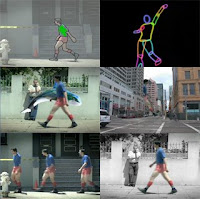 If you want to remove unwanted objects from video, you want to rotoscope them out. You can sorta do rotoscoping in After Effects, though much more effectively with the Silhouette FX Roto filters inside AE. Roto is more involved than you might think, and can be done with masking, tracking, paint, and procedural effects in a variety of apps including Motor, Mocha, PF Hoe, Syntheyes, etc.
If you want to remove unwanted objects from video, you want to rotoscope them out. You can sorta do rotoscoping in After Effects, though much more effectively with the Silhouette FX Roto filters inside AE. Roto is more involved than you might think, and can be done with masking, tracking, paint, and procedural effects in a variety of apps including Motor, Mocha, PF Hoe, Syntheyes, etc.Rotoscoping has been explained by Matt Silverman of Commotion fame in The Art of Roto and by Commotion's creator and ILM alumni Scott Squires in blog posts and movies at his Effects Corner. More recently fx guide's The Art of Wire Removal covered some of the same ground talking to a supervisor at The Orphanage.
Rotoscoping isn't always hard, especially if you have a locked down camera and a clean frame plate to clone from. I'm not sure how much roto can be pulled off in Motion though someone has tried it and prefers the now-dead Shake. Mark Christiansen provides some help in his book After Effects Studio Techniques, as does Chris & Trish Meyer in Creating Motion Graphics. Also, Pete O'Connell has a tutorial movie at Creative Cow: Rotoscoping in AE.
Pixel Corps has got some training and discounts in this area and has an upcoming online roto class with J. Bills (registration closes today). FxPhd also has good cheap classes -- this term on several apps you could use in roto, including Shake and the suite of Imagineer products.
Update: I can't believe this still exists on a Pinnacle site since they retired Commotion long ago, "Confessions of a Roto Artist: Three Rules For Better Mattes," by Scott Stewart (PDF).
Update: There's much more on roto tips and tutorials in Rotoscoping tips and other posts tagged roto.
1 comment:
A very comprehensive post on rotoscoping.. nice.. very informative.. A very popular example of rotoscoping work is the ever talked about "A Scanner darkly".. Wherein Richard Lanklater employed rotoscoping to give the film a cartoon like effect.
Rotoscoping & Chroma keying
Post a Comment